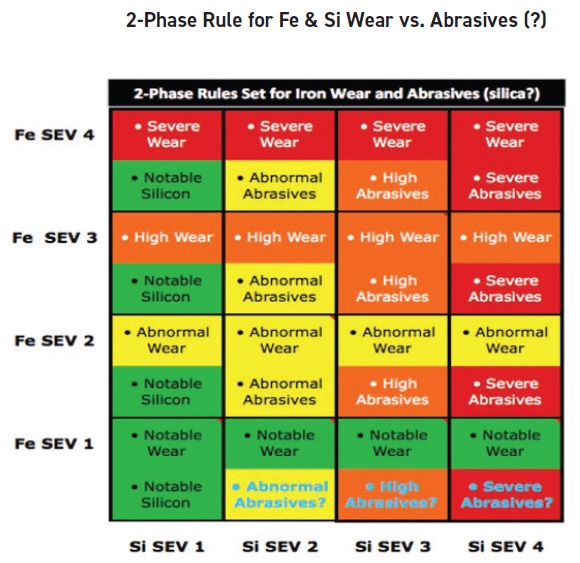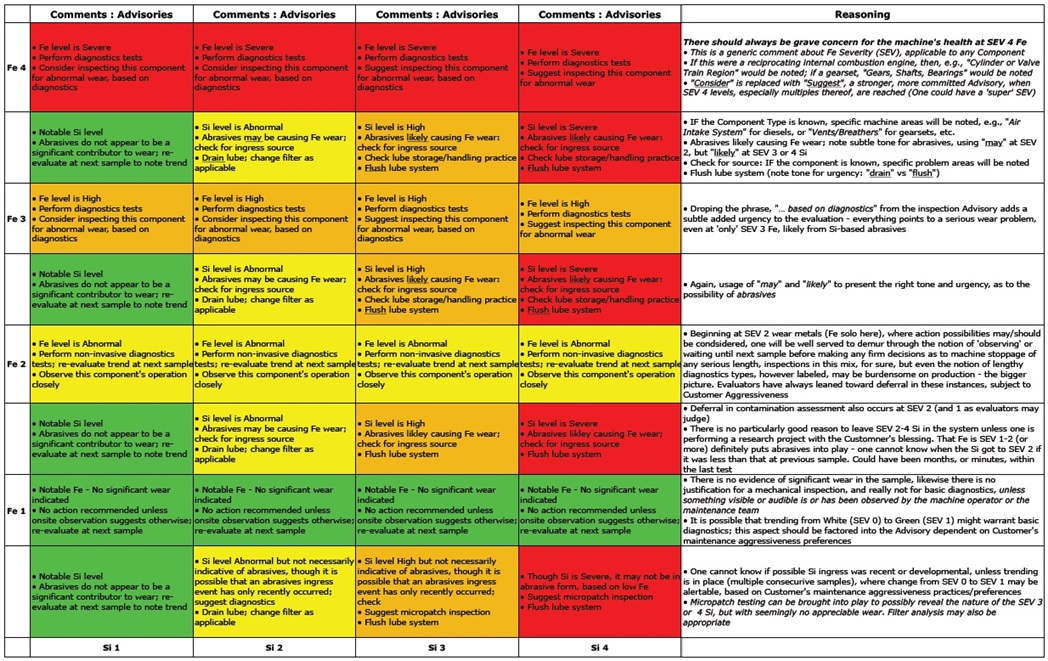Complexity in ISFA (in-service fluid analysis): Part XLI
Jack Poley | TLT On Condition Monitoring November 2018
Holistic CM in the 21st Century: Part XIII
Continuing to fill in our expert system (EXSYS) two-phase Fe/Si rule, the macro rule (objective) is shown in Figure 1, yet again, for reference. We completed the lockstep part of the rule, where Fe/Si colors are matched and the initial conclusion,
that Si is causing Fe wear, was fleshed out. Now we finish the rule for the remaining 12* propositions, those where coloration is not identical.
 Figure 1. Fe versus Si.
*There are actually 32 separate propositions linked by twos, because in any two-phase rule, two datum pieces are being matched up for a composite advisory—having 16 possibilities, wherein the evaluator should assess what influence each datum exerts on the other for each combination of colors (see Figure 2).
Figure 1. Fe versus Si.
*There are actually 32 separate propositions linked by twos, because in any two-phase rule, two datum pieces are being matched up for a composite advisory—having 16 possibilities, wherein the evaluator should assess what influence each datum exerts on the other for each combination of colors (see Figure 2).
 Figure 2. Fleshed out 16-proposition, 32-combination phase-two rule for Fe/Si.
Figure 2. Fleshed out 16-proposition, 32-combination phase-two rule for Fe/Si.
Some rules development posits:
1.
We have already done the stats to determine the appropriate coloration of the results based on table of boundaries (TOB) numeric or other test results—so we don’t need to deal with this complexity in composing rules. We can always change the ranges of coloration to create triggers at any data points to achieve the desired
urgency, based on any or all combinations of:
a.
Customer (usually the most precise point).
b.
Component type (a required feature in all EXSYS activity).
c.
Component manufacturer (MFR) and model. MFR alone also is a valid stepping stone—model adds nuance, sometimes quite significant.
d.
Application or duty cycle (usually a very important consideration).
e.
Special wild card (2) situations (e.g., ceramic components).
f.
Lubricant in use (if fully identified as to brand, not just Shell, ExxonMobil, etc.).
2.
The example in Figure 1 is a generic rule that fires anytime both Fe and Si are not White (SEV 0).
a.
It operates independently of, say, Fe/Cu or Al/Si.
b.
If rules exist for Fe or Si by themselves—and they do, of course—the two-phase composite rule trumps both individual single-phase rules. Since Fe/Si add nuance when evaluated jointly, any aspect of the individual rule can be rolled up, morphed or ignored as suits the joint evaluation of Fe and Si, as would most likely occur since another data point was introduced, causing a dependency as dictated by the rule.
c.
Yes, if a three-phase rule, such as Fe/Si/Cu were created, this would trump our two-phase rule that trumped the single-phase Fe and Si rules. Trumping only occurs when the higher rule order (number of differentiated datum pieces, up to four-phase) contains all datum type members in the lower-order rule, thus, Fe/Si/Cu and Fe/Si/Al would co-exist but would both trump Fe/Si, and Fe/Si/Cu/Pb would only trump Fe/Si/Cu.
3.
What if a rule is
good for some customers or component types or manufacturers but not adequate or accurate for others?
The same differentiators that are used for TOBs, in order to rate data, can be used for rules, and even advisory content, wherein a different comment is created for certain situations (e.g., a specific entity’s component type and manufacturer, even though the same rule was fired). This allows nearly unlimited granularity to creating rules and the advisories that follow, based on unique constraints. This is a typical hierarchy info drill down—other orders can readily be created:
a.
Customer
b.
Component type
c.
Manufacturer (MFR)
• Model
d.
Application
• e.g., off highway or mining
e.
Wild cards (2).
Each drill down trumps the preceding by way of adding another attribute as a means of best definition of the lube sample’s source; however, a field gap, followed by a field fill in the attribute hierarchy, creates a lower (best definable) drill down, trumping the lesser content in terms of perceived importance, provided all the trumped list’s attributes also are accounted for. Thus:
a.
Customer
b.
Component type
c.
Manufacturer
• Model
trumps
a.
Customer
b.
Component type
c.
Manufacturer
that trumps
a.
Customer
b.
Component type
c.
(Manufacturer null)
d.
Application
e.
Wild card 1
f.
Wild card 2.
Once the highest contiguous hierarchy order is breached by a void/null, additional fills after the breach still inform the comparison, enabling further drill down to complete the rule (or TOB) selection.
Once the hierarchy assigns a
best fit rule, the comments forming the advisory can be selected using a different hierarchy constraint as preferred.
What makes an EXSYS ultimately better than an
unarmed evaluator is that
advisories (remember the purpose of ISFA) are absolutely consistent. And when those things need correction, or upgrading, the EXSYS only improves, sometimes geometrically so. It only gets better at being an absolutely consistent evaluator. Adding a collaborative capability allows expertise to be injected from any qualified source.
With all the (sudden) attention given over the last couple years to AI, IIoT, Industry 4.0 (I doubt I need to translate these), one can see that it’s inevitable that all condition monitoring data will be increasingly monitored and amalgamated into the most informed machine status determination. More on this next article.